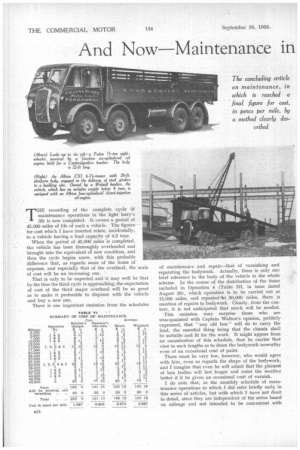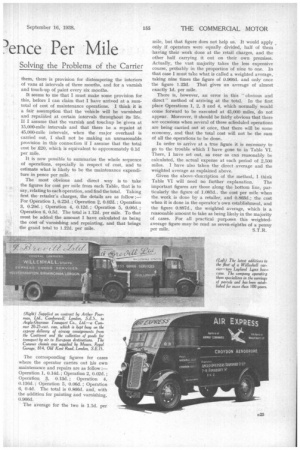And Now Maintenance in ence Per Mile
Page 34

Page 35

If you've noticed an error in this article please click here to report it so we can fix it.
The concluding article on maintenance, in which is reached a final figure for cost, in pence per mile, by a method clearly des cribed
THE recording of the complete cycle of maintenance operations in the light lorry's life is now completed. It covers a period of 45,000 miles of life of such a vehicle. The figures for cost which I have inserted relate, incidentally, to a vehicle having a load capacity of 4-5 tons.
When the period of 45,000 miles is completed, the vehicle has been thoroughly overhauled and brought into the equivalent of new condition, and then the cycle begins anew, with this probable difference that, as regards some of the items of expense, and especially that of the overhaul, the scale of cost will be an increasing one.
That is only to be expected and it may well be that by the time the third cycle is approaching, the expectation of cost of the third major overhaul will be so great as to make it preferable to dispense with the vehicle and buy a new one.
There is one important omission from the schedules of maintenance and repair—that of varnishing and repainting the bodywork. Actually, there is only one brief reference to the body of the vehicle in the whole scheme. In the course of the distribution of the items included in Operation 4 (Table III, in issue dated August 26), which operation is to be carried out at 15,000 miles, and repeated't 30,000 miles, there is mention of repairs to bodywork. Clearly, from the context, it is not anticipated that much will be needed.
This omission may surprise those who are unacquainted with Captain Walton's opinion, publicly 'expressed, that "any old box" will do to carry the load, the essential thing being that the chassis shall be suitable and fit for the work. It might appear from an examination of this schedule, that he carries that view to such lengths as to deem the bodywork unworthy even of an occasional coat of paint.
There must be very few, however, who would agree with him, even as regards the shape of the bodywork, and I imagine that even he will admit that the plainest of box bodies will last longer and resist the weather better if it be given an occasional coat of varnish.
I do note that, in the monthly schedule of maintenance operations to which I did refer briefly early in this series of articles, but with which I have not dealt in detail, since they are independent of the series based on mileage and not intended to he concurrent with
them, there is provision for distempering the interiors of vans at intervals of three months, and for a varnish and touch-up of paint every six months.
It seems to me that I must make some provision for this, before I can claim that I have arrived at a sumtotal of cost of maintenance operations. I think it is a fair assumption that the vehicle will be varnished and repainted at certain intervals throughout its life. If I assume that the varnish and touchup be given at 15,000-mile intervals and that there be a repaint at 45,000-mile intervals, when the major overhaul is carried out, I shall not be making an unreasonable provision in this connection if I assume that the total cost be £20, which is equivalent to approximately 0.1d per mile.
It is now possible to summarize the whole sequence of operations, especially in respect of cost, and to estimate what is likely to be the maintenance expenditure in pence per mile.
The most obvious and direct way is to take the figures for cost per mile from each Table, that is to say, relating to each operation, and find the total. Taking first the retailer's charges, the details are as follow :— For Operation 1, 0.22d.; Operation 2, 0.02d. ; Operation 3, 0.20d. ; Operation 4, 0.12d.; Operation 5, 0.06d. ; Operation 6, 0.5d. The total is 1.12d. per mile. To that must be added the amount I have calculated as being the cost of varnishing and repainting, and that brings the grand total to I .22d. per mile, The corresponding figures for cases where the operator carries out his own maintenance and repairs are as follow :— Operation 1, 0.14d.; Operation 2, 0.02d.; Operation 3, 0.13d.; Operation 4, 0.116d.; Operation 5, 0.06d.; Operation 6, 0.4d. The total is 0.866d. and, with the addition for painting and varnishing, 0.966d.
• The average for the two is 1.1d. per
mile, but that figure does not help us. It would apply only if operators were equally divided, half of them having their work done at the retail charges, and the other half carrying it out on their own premises. Actually, the vast majority takes the less expensive course, probably in the proportion of nine to one. In that case I must take what is called a weighted average, taking nine times the figure of 0.966d. and only once the figure 1.22d. That gives an average of almost exactly id. per mile.
There is, however, an error in this " obvious and direct" method of arriving at the total. In the first place Operations 1, 2, 3 and 4, which normally would come forward to be executed at 45,000 miles, do not appear. Moreover, it should be fairly obvious that there are occasions when several of these scheduled operations are being carried out at once, that there will be some economy, and that the total cost will not be the sum of all the operations to be done.
In order to arrive at a true figure it is necessary to go to the trouble which I have gone to in Table VI. There, I have set out, as near as can reasonably be calculated, the actual expense at each period of 2,500 miles. I have also taken the direct average and the weighted average as explained above.
Given the above-description of the method, I think Table VI will need no further explanation. The important figures are those along the bottom line, particularly the figure of 1.087d., the cost per mile when the work is done by a retailer, and 0.863(1.7 the cost when it is done in the operator's own establishment, and the figure 0.887d., the weighted average, which is a reasonable amount to take as being likely in the majority of cases. For all practical purposes this weightedaverage figure may be read as seven-eighths of a penny per mile. • S.T.R.




















































































